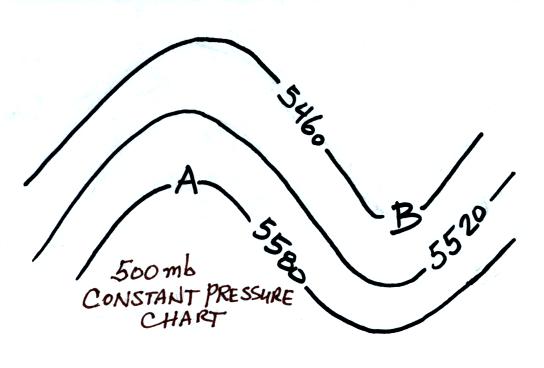Quiz
#1 Study Guide (preliminary)
Questions
on Quiz #1 will come
from topics on this study guide together with material on the Practice
Quiz Study Guide .
***
Chapter 6 (p. 144) ***
Ideal Gas Law.
This is
a
microscopic-scale explanation of air pressure. Two equations
P = N k T / V and P = (rho) R
T. N is the number of air molecules in
a
volume V. T is temperature and rho
is density. R and k are both constants. You
should be able to determine what will happen to the
pressure in a balloon if you change the variables in the
equation above. What variables could you change together in such
a way
that the pressure
would stay constant?
Ideal gas law
applications. If you heat or cool a parcel of air in the
atmosphere, Charles' law says the density
(volume)
will change in such a way that the air pressure inside the parcel
remains constant (remains the same as the pressure of the air
surrounding the parcel).
Upward and downward forces act on air parcels (the
strength of one of the forces depends on the air inside the parcel, the
other on the air outside the parcel). These two forces are usually in
balance. What happens to the balance when you warm or cool a parcel of
air? Basically you should be able to explain why a balloon of hot
low density air rises and a balloon of cold high density air sinks.
Sample questions
Quiz #1: 13, 14, 16
Final Exam: 22, 41
***
Chap. 1 (pps 13-18), Chap. 6 (pps 141-149), Appendix C (pps 431-432)
***
Station model notation.
Cloud cover, temperature, dew point temperature (typical values for
Tucson), wind direction and speed, common weather symbols (rain, snow,
fog, rain shower, thunderstorm, tropical storm and hurricane),
pressure. Units. After pressure is measured, what important
adjustment
is made before the pressure is plotted on the surface map? Why is that
necessary? Average and typical range of sea-level pressure values.
Surface weather maps.
Surface observations are made and a new map is prepared hourly. What
time zone or time reference is used? 24-hour clock (what time is it
when it is 17:30 in Tucson). Isobars and isotherms. Small horizontal
differences in pressure cause the wind to blow. Air motions around high
and low pressure centers (northern hemisphere). Strong and weak
pressure gradients. Convergence and divergence. Rising and sinking air
motions. How do wind motions around highs and low affect the
temperature pattern? Cold fronts and warm fronts (where is the warm and
cold air, what direction are they moving)..
Upper level charts
(see pps
115-119 & 41,42, 42a?, and 42b? in the photocopied notes).
Ridges
(warm air below) and troughs (cold air below). Winds blow parallel to
contour lines and from west to east.
Pressure decreases with increasing altitude in the
atmosphere. Does pressure decrease more quickly in warm or cold air,
in high or low density air? Why? Are upper level conditions normally
displayed on constant altitude or constant pressure charts?
How does the pressure at point A in the crossectional figure
below at
right compare with the pressure at Point B? Is the coldest air
found on the right or left hand side of the figure? Is pressure
decreasing most rapidly with increasing altitude on the right or left
side of the figure?
What do the numbers on the contour lines on the constant pressure
(isobaric) map above at left represent? Is the coldest air
found in the north or
south? Is the air below Point A warmer or colder than
the air below Point B. Is Point A in a ridge or a trough?
Is this a northern or a southern hemisphere
chart? Is the pressure at Point A on the map higher, lower,
or the same as the pressure at Point B? How do the altitudes at the
two points compare?
Would upper-level convergence
cause surface pressure to increase or decrease?
Is upper level convergence or divergence needed to cause an
extratropical cyclone to intensify?
Sample questions
Practice Quiz: 2, 10, 11, 14,
19
Quiz #1: 6, 7, 8, 9, 10,
11
Final Exam: 3, 7, 10, 17, 26, 34, 52
Reviews
Mon.
Tue.
Wed.
|
4-5 pm
4-5 pm
4-5 pm
|
FCS 225
FCS 225
FCS 225
|



